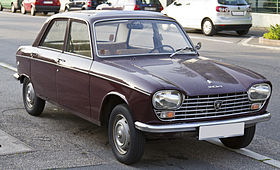Peugeot 204
| Peugeot 204 | |
|---|---|
 |
|
| Overview | |
| Manufacturer | Peugeot SA |
| Production | 1965–1976 1,604,296 produced |
| Designer |
Battista Pininfarina 1893–1966 |
| Body and chassis | |
| Class | Small family car (C) |
| Body style | 4-door sedan 4-door estate (break) 2-door coupé 2-door convertible 2-door van |
| Layout | FF layout |
| Related | Peugeot 304 |
| Powertrain | |
| Engine | 1.1 L I4 1.3 L diesel I4 1968–1973 1.4 L diesel I4 1973–1976 |
| Dimensions | |
| Wheelbase | 2,595 mm (102.2 in) |
| Length | 3,990 mm (157 in) |
| Width | 1,560 mm (61 in) |
| Height | 1,400 mm (55 in) (saloon empty) 1,340 mm (53 in) (saloon loaded) |
| Curb weight | 851 kg (1,876 lb) |
| Chronology | |
| Successor | (Peugeot 304) |
The Peugeot 204 is a small family car produced by the French manufacturer Peugeot between 1965 and 1976.
The 204, known in development as Project D12, was available in many body styles including a sedan/saloon/berline, convertible/cabriolet, hatchback/coupe, estate/wagon, and a van. It was launched in Paris, France on 23 April 1965 and became the best-selling car in France from 1969 to 1971.
The 204 used a front-wheel drive layout and was launched with a single overhead cam 1130 cc gasoline engine (the maximum allowed for the 6CV 'car tax' class in France). In September 1975, less than a year before production ceased, it received a more modern petrol engine, now of 1127 cc. Claimed maximum output, which at launch had been 53 bhp (39 kW), increased to 59 bhp (43 kW), though there was a marginal reduction in maximum torque.
Following the demise of the 204 the new 1127 cc engine found its way into a version of the Peugeot 304 estate: the smaller engine enjoyed in France tax benefits when compared to the 1290 cc engines fitted to most 304s.
For certain export markets engine compression ratios and power on the petrol/gasoline engines were reduced in order to accommodate lower octane fuels.
Towards the end of 1968 a 1255 cc diesel engine option became available for the 204 estate and fourgonette (van) versions. At the time, this is thought to have been the smallest diesel engine fitted in a commercially available car anywhere in the world. In April 1973 the diesel unit was increased in size to 1357 cc, and in September 1975 this diesel unit finally became an option on the 204 saloon. Fuel economy on the 204 Diesel was startlingly good, with overall fuel consumption at 5.7 litres per 100 km (roughly 41 mpgUS): performance was correspondingly underwhelming with a claimed top speed of 130 km/h (81 mph). Out of the approximately 150,000 diesel 204s produced, fewer than 30,000 were saloons. Until the early 1980s when Volkswagen started heavy promotion of their diesel-engined Golf / Rabbit, and unless cars were large enough to be used as taxis, most European customers for saloon cars avoided diesel engines.
204 engines were aluminium and transversely mounted which increased available passenger space within a given wheelbase: the 204 was the first production Peugeot to feature this format which later would become normal for small and medium-sized front-wheel-drive Peugeot passenger cars.
...
Wikipedia
